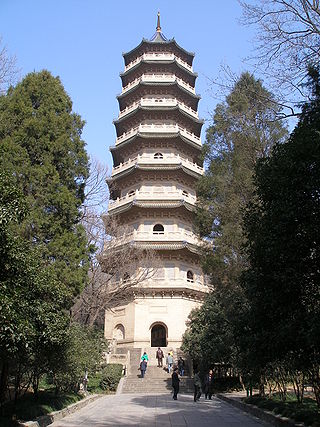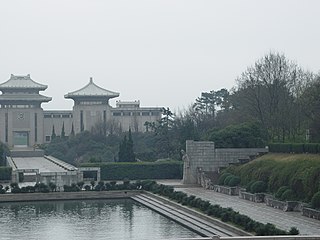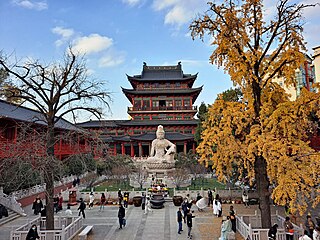16 Sights in Nanjing, China (with Map and Images)
Legend
Welcome to your journey through the most beautiful sights in Nanjing, China! Whether you want to discover the city's historical treasures or experience its modern highlights, you'll find everything your heart desires here. Be inspired by our selection and plan your unforgettable adventure in Nanjing. Dive into the diversity of this fascinating city and discover everything it has to offer.
The Presidential Palace in Nanjing, Jiangsu, China, housed the Office of the President of the Republic of China from 1927 until the capital was relocated to Taipei in 1949. It is now a museum called the China Modern History Museum. It is located at No.292 Changjiang Road, in the Xuanwu District of Nanjing.
The Nanjing Museum is located in Nanjing, the capital of Jiangsu in East China. With an area of 70,000 square metres, it is one of the largest museums in China, with over 400,000 items in its permanent collection. Especially notable is the museum's enormous collections of Ming and Qing imperial porcelain, which is among the largest in the world.
3. The Memorial for compatriots killed in the Nanjing Massacre by Japanese Forces of Aggression
The Memorial Hall of the Victims in Nanjing Massacre by Japanese Invaders is a museum to memorialize those that were killed in the Nanjing Massacre by the Imperial Japanese Army in and around the then-capital of China, Nanjing, after it fell on December 13, 1937. It is located in the southwestern corner of downtown Nanjing known as Jiangdongmen (江东门), near a site where thousands of bodies were buried, called a "pit of ten thousand people".
Wikipedia: Memorial Hall of the Victims in Nanjing Massacre by Japanese Invaders (EN), Website
4. Xuanwu Lake Park
Xuanwu Lake is located in Xuanwu District in the central-northeast part of Nanjing, Jiangsu. It is near the Nanjing Railway Station and Jiming Temple. Five islands within the lake are interconnected by arched bridges. Within the park are temples, pagodas, pavilions, gardens, teahouses, restaurants, entertainment venues, a small zoo, and other attractions. Its main entrance is the Xuanwu Gate.
5. 雨花台风景名胜区
Yuhuatai is also known as "Shizigang", "Agate Gang", "Jubao Mountain", is a hill with an altitude of 60 meters outside the Zhonghua Gate in the south of Nanjing. Yuhuatai is a Buddhist resort in ancient times, in the second year of Nanliang Tianjian (503 years), because Master Yunguang set up an altar to preach the scriptures in the hill where Yuhuatai is located, he was pious, moved to the heavens, and the flowers fell like rain, so he got the name. In the Ming and Qing dynasties, Yuhuatai's "Yuhua Saying" and "Mumo Wind High" were listed as one of the "Eighteen Views of Jinling" and "Forty-eight Views of Jinling" respectively. During the Republic of China, Yuhuatai was a torture ground. It is now a scenic spot in Yuhuatai.
6. Qixia Temple
Qixia Temple is a Buddhist temple located on Qixia Mountain in the suburban Qixia District of Nanjing, Jiangsu, 22 kilometres (14 mi) northeast of downtown Nanjing. It is one of Nanjing's most important Buddhist monasteries. The temple is the cradle of East Asian Mādhyamaka.
7. Imperial Examinations History Museum

The Jiangnan Examination Hall, near the Confucius temple, is located in the southern part of Nanjing, Jiangsu Province, China. It is the largest examination hall for imperial examination in ancient China. It now houses the Imperial Examination Museum.
8. 赛珍珠故居
Located in the North Park of Nanjing University in Gulou District, Nanjing, Nanjing Pearl Race Former Residence is the former residence of American writer Pearl Race in Nanjing, which is a two-story brick and concrete structure of the western-style building.
9. 无梁殿(辛亥革命烈士蜡像馆)
Linggu Temple Beamless Hall is a Ming Dynasty building in Linggu Park at the southern foot of Purple Mountain in Nanjing, Jiangsu Province, China, and is a cultural relics protection unit in Jiangsu Province. The hall was built in the 14th year of Hongwu (1381), originally the Amitayus Hall dedicated to the Buddha of Amitayus in the Linggu Temple, because the whole building adopts the brick arch structure, no wooden beams, so it is also called "the hall without beams". In the twenty-first year of the Republic of China (1931), the National Government rebuilt the Wuliang Hall into the memorial hall of the National Revolutionary Army Memorial Cemetery, and named it "Zhengqi Hall". The beamless hall is now a wax museum for celebrities of the Xinhai Revolution.
10. 中国共产党代表团梅园新村纪念馆

The Meiyuan New Village Memorial Hall of the Communist Party of China Delegation is a special memorial hall to commemorate the peace negotiations between the Chinese Communist Party delegation headed by Zhou Enlai and the Nationalist Government in Nanjing from May 1946 to March 1947. The memorial hall includes the former site of the office of the Communist Party of China delegation (the fourth batch of national key cultural relics protection units), the exhibition hall of the Nanjing negotiation history of the Kuomintang and the Communist Party, the bronze statue of Zhou Enlai and the library of Zhou Enlai. The memorial hall was built in 1954 and officially opened in 1977, with the name inscribed by Yang Shangkun. On January 8, 1990, the Historical Exhibition Hall was opened. On July 1, 1990, the bronze statue of Zhou Enlai was completed. On February 21, 1998, Zhou Enlai Library was opened.
11. 阵亡将士公墓

The National Revolutionary Army War Memorial Cemetery in Nanjing was used for burials between 1931 and 1935. It is located at Purple Mountain in the east of Nanjing, and lies west of the Sun Yat-sen Mausoleum, occupying about one square kilometer. After the founding of the People's Republic of China it was renamed "Hope Valley Park."
Wikipedia: National Revolutionary Army Memorial Cemetery (EN)
12. Yuejiang Tower

Yuejiang Tower is situated on the top of Shizishan to the northwest of downtown Nanjing, Jiangsu. The river referred to its name is the Yangtze River, which may be viewed to the north, while central Nanjing can be viewed to the south.
13. Pilu Temple
Nanjing Pilu Temple is located in Hanfu Street, Xuanwu District, Nanjing City, Jiangsu Province. Because the temple is dedicated to the Buddha Virujana, the original name is Piluan. Virujana Buddha, Chinese translation: Dari Rulai, is the supreme Buddha-figure of Buddhist Tantra, the Buddha of the highest level of Tantra, and the highest deity revered by Buddhist Tantra. All the Buddhas and Bodhisattvas of Tantra come from the Great Ri Nyorai, and in the two mandalas of the Vajra realm and the Tibetan realm, the Great Ri Nyorai is in the central position, and he commands all the Buddhas and Bodhisattvas, and he is the root Buddha of the Buddhist Tantric world.
14. 何应钦公馆旧址
The former site of He Yingqin's Mansion is located in the North Park of Nanjing University Gulou Campus, Gulou District, Nanjing, Jiangsu Province, China, and on the northeast side of the Physics Building of Nanjing University.
15. Great Bao'en Temple
The Porcelain Tower of Nanjing, part of the former Great Bao'en Temple, is a historical site located on the south bank of external Qinhuai River in Nanjing, China. It was a pagoda constructed in the 15th century during the Ming dynasty, but was mostly destroyed in the 19th century during the course of the Taiping Rebellion. A modern, full-size replica of it now exists in Nanjing.
16. 圣保罗堂
St. Paul's Church is a famous Christian church located at 396 Taiping South Road, Nanjing, Jiangsu Province, China. Founded by the American Anglican Church from 1913 to 1923 and later administered by the Chinese Anglican Church of Jiangsu, the exterior is Gothic-style, with a towering bell tower, but the interior is made of traditional Chinese wooden frames. The exterior walls are made of polished city wall bricks, and the window bases, buttresses and other parts are carved in white stone. The total cost is $12,000. In 1935, the number of members of St. Paul's Church grew to more than 1,000, and there were branches in the two towns of Dongliu and Tangshan. St. Paul's Church continued to worship normally until the outbreak of the Cultural Revolution in 1966, when it was occupied by a factory. On July 28, 1985, it was officially reopened. It is now a cultural relics protection unit in Jiangsu Province.
Share
How likely are you to recommend us?
Disclaimer Please be aware of your surroundings and do not enter private property. We are not liable for any damages that occur during the tours.







.jpg)



